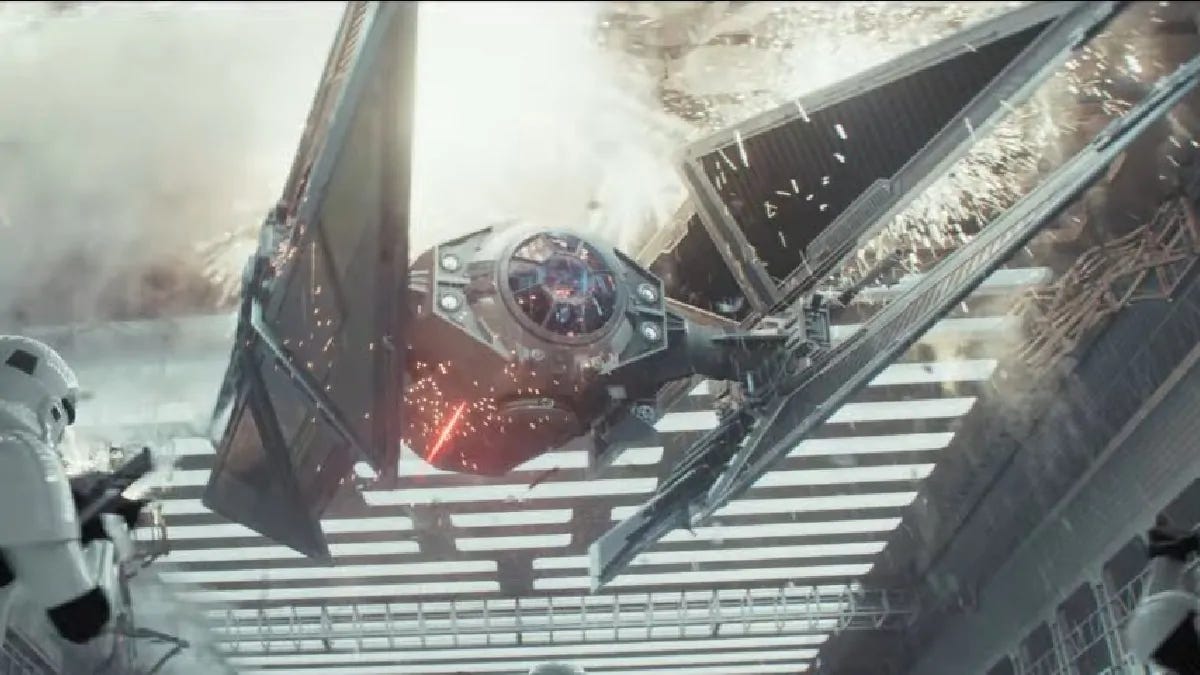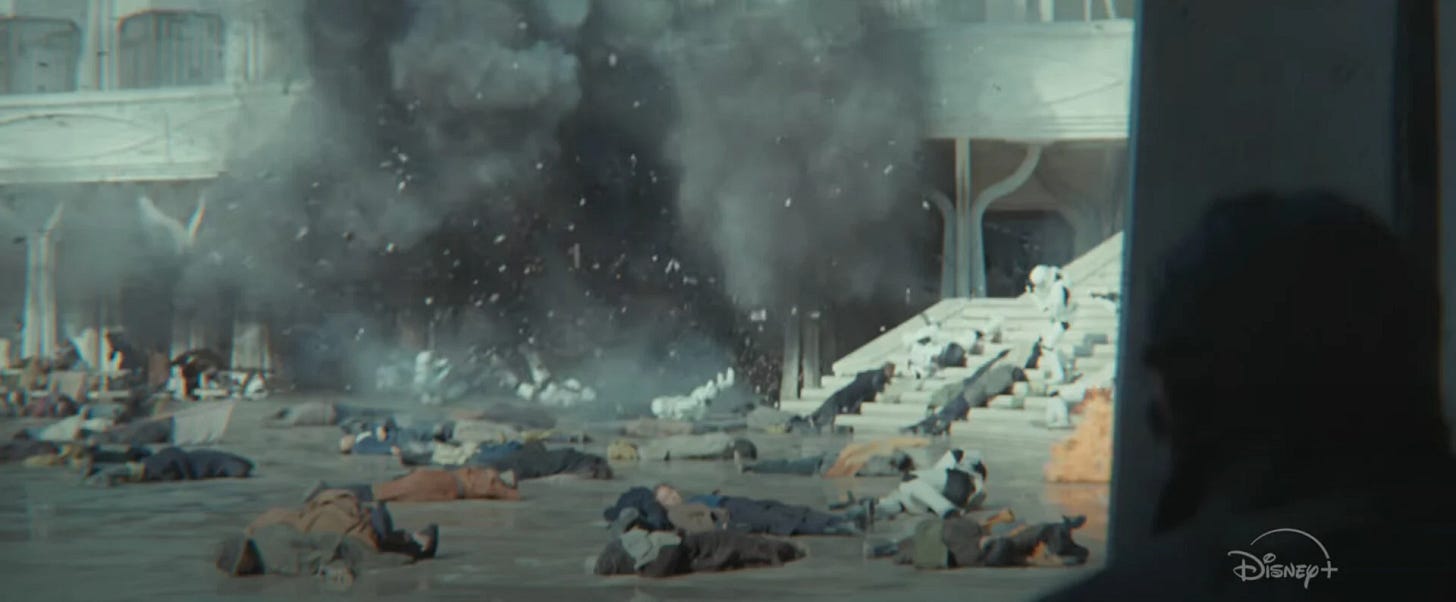'Andor' is the Star Wars I Never Knew I Wanted
We won't be seeing a Disney show like this again.

Foreign Perspectives is a mix of free and paid content. Certain columns such as these are free for all subscribers, but other articles will be exclusive for paid subscribers. If you enjoy the work I do, please consider upgrading to a monthly or yearly subscription. Your support is greatly appreciated and ensures that this Substack can continue to deliver high quality pieces.
Note: This piece discusses Andor’s premise and themes in general terms, but avoids major show spoilers. It does, however, spoil other Star Wars films including Rogue One.
Who would have guessed that the best piece of Star Wars media in years would be an interquel television show that also serves as a prequel to a prequel? That may sound like opening to a random chapter in a sprawling epic novel, but not to worry. Series creator Tony Gilroy always intended for Andor to be something both Star Wars fans and non-fans alike could enjoy. God knows that the brand certainly needs it now. Against all odds, this spin-off to the already excellent Rogue One film is hands down the strongest entry Star Wars has seen under Disney. Not only that, it’s simply damn good television that everyone should watch.
Andor has finished its all-too-brief run of 24 episodes across two seasons, but I’m confident that this is a series that will stand the test of time and be fondly remembered as something that only comes around every decade or so. From its impeccable production design on real sets to its introspective writing which puts most Hollywood films and television shows to shame, it’s easy to forget that this is indeed a Disney-made Star Wars project. It defies all the expectations of a prestige television show released in the “art reduced to content” era of modern streaming, which is something the House of Mouse themselves played a direct hand in creating.
What’s all the more amazing is that Gilroy has openly admitted to not being a hardcore fan of Star Wars. While he watched George Lucas’ original film when it first came out in 1977 like millions of others, his approach to storytelling is worlds apart. Coming from a family with a long history in the arts, Gilroy is primarily known for being the director and screenwriter of the action thriller Jason Bourne franchise and more cerebral dramas like Michael Clayton. At first glance, he does not seem like someone suited for space opera fantasy at all. Yet Andor ended up becoming the best Star Wars show not because it’s deeply seated in established lore, but because Gilroy put strong writing and moving parallels to real-world history ahead of everything else.
Andor is set five years before the Battle of Yavin, or 5 BBY as per the now official dating system of the Star Wars timeline. Audiences will remember this pivotal moment as the conclusion to A New Hope when Luke Skywalker successfully destroys the Death Star. Yet the path to defat the evil Empire’s massive space station with the capability to blow up entire planets was hardly a straightforward one. Andor’s premise centers around the years of spycraft, guerrilla missions, and sabotage it took for the Rebel Alliance to come together into one organized entity — as well as the countless lives lost in their struggle against the Empire.
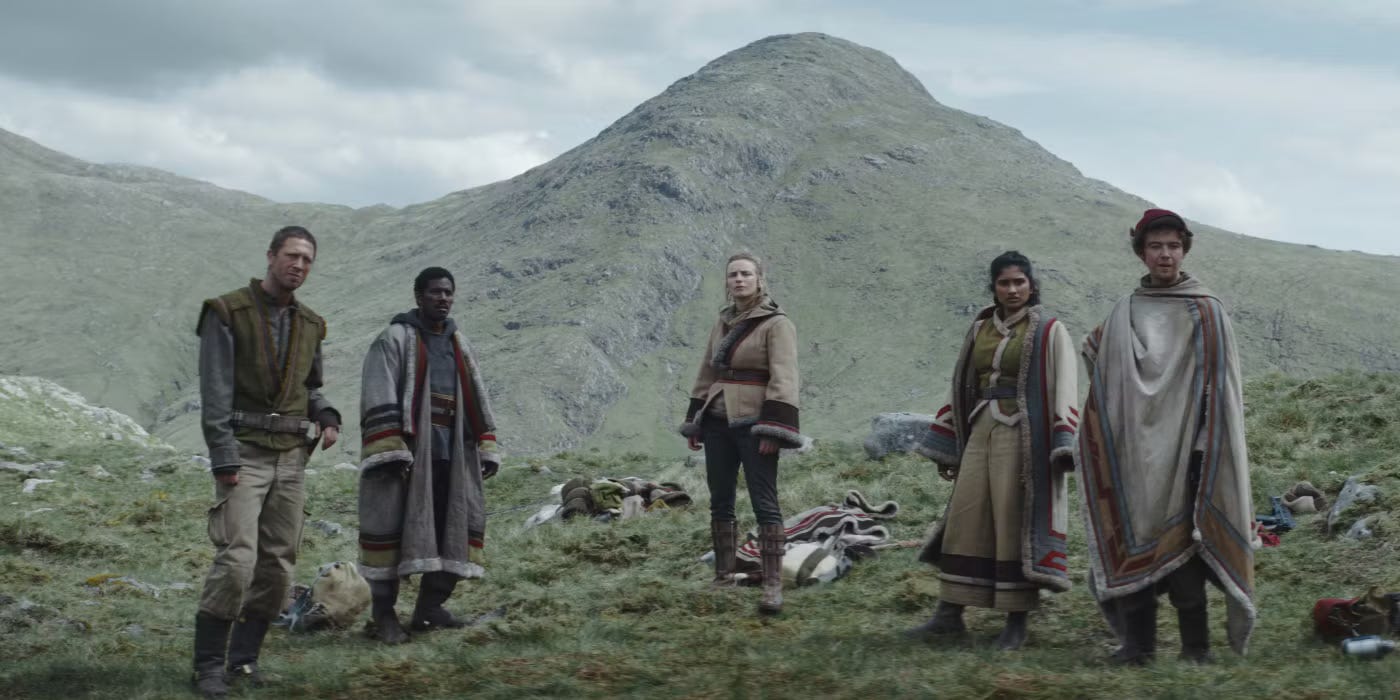
The great man theory posits that talented, ambitious, resourceful, or otherwise extremely intelligent individuals are the ones who drive history. These are the household names ranging from Alexander the Great to Adolf Hitler. If these men did not act in the ways they did, then the times we live in now could have ended up very differently. George Lucas being heavily inspired by the “hero’s journey” template as popularized by Joesph Campbell is why his six Star Wars movies lean heavily into “great men” and related mythology. Andor, however, is the inversion of such themes.
The eponymous protagonist of the series, Cassian Andor (Diego Luna), first appeared in Rogue One as the operative tasked with assassinating the lead engineer of the Death Star. In that film, we seem him as a dedicated member of the Rebel Alliance who sacrifices his own life in the process of furthering its goals. Andor shows how Cassian radically changes his outlook over time in going from a selfish survivor to a fighter believing in a higher cause. Yet despite being named after him, it can be argued that the series is more about the Rebels’ overall struggle against the Empire as a whole. If George Lucas’ Star Wars is an epic tale of great men, then Tony Gilroy’s Andor is the behind-the-scenes backstory of the nameless heroes who fall through the cracks of history to help them.
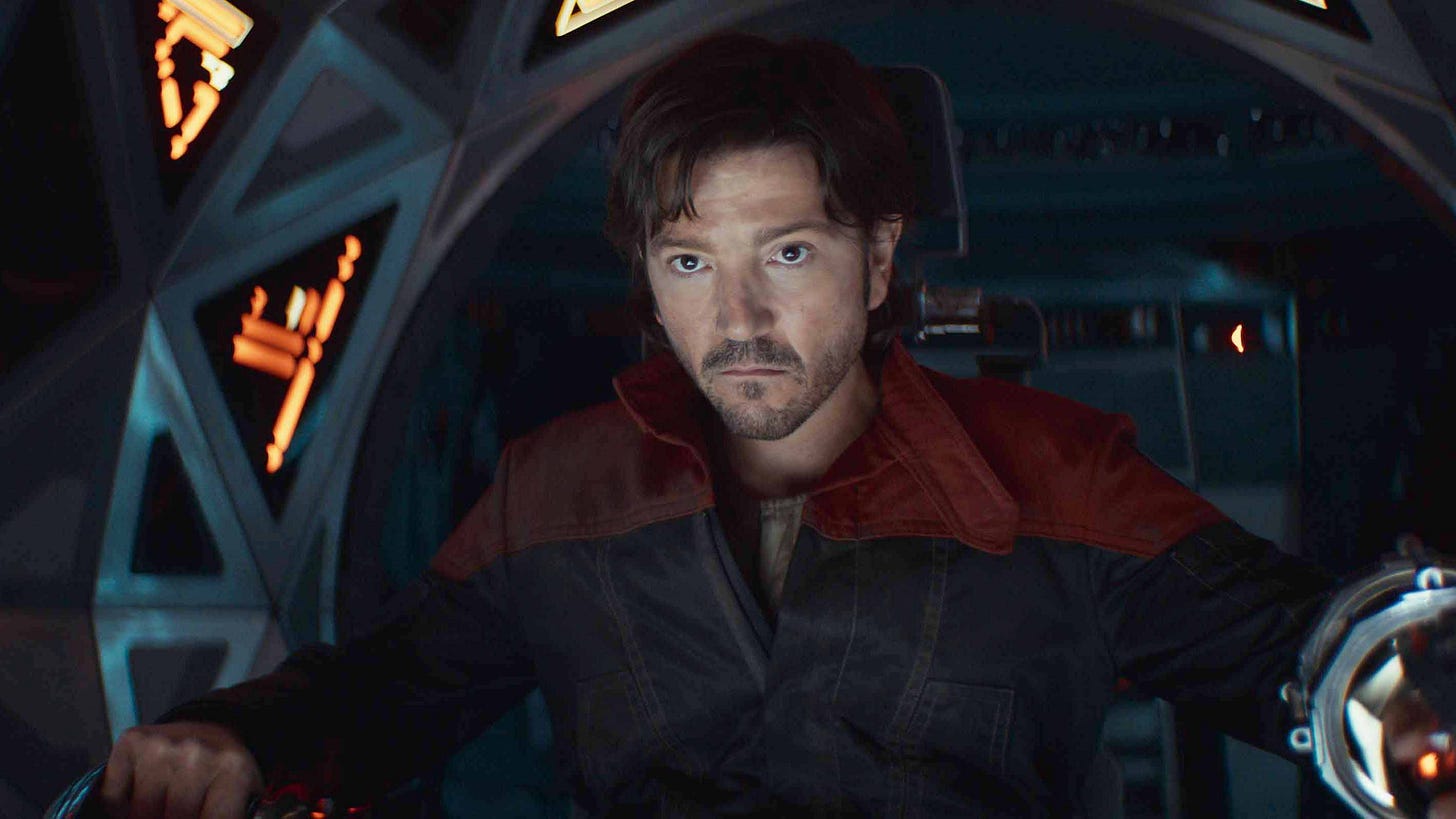
Just as Cassian kills a fellow Rebel spy who turns out to be a liability at the beginning of Rogue One, Andor contextualizes the difficult choices resistance fighters have to make in order for their cause to survive. Central to that is Luthen Rael (Stellan Skarsgard), a brutal leader who makes first contact with Cassian and changes his life forever by bringing him into the rebellion. Luthen is a man of two faces; by day he’s a smiling seller of antiques on Coruscant, by night he’s a callous operator willing to make any sacrifice necessary to fight back against the Empire. Throughout Andor we’re only given bits and pieces of his backstory, but by the end we’re given a portrait of an incredibly complex man far deeper than your average Star Wars character.
The other important figure of the rebellion is Senator Mon Mothma (Genevieve O’Reilly). Originally only a small supporting character in 1983’s The Return of the Jedi, her character has since been greatly expanded in other Star Wars media. Andor fleshes her out even more. Like Luthen, Mon is a complex figure who has to play dual roles as both a loyal Imperial subject and covert resistor. Her wealth is a vital asset to funding the rebellion, but such privilege means she is constantly in the public eye. This is in contrast to Mon’s cousin Vel Sartha (Faye Marsay) who has much more freedom to be on the front lines, leading to subtle feelings of jealousy.

Significant time is also dedicated to depicting the brutality of the Empire and those part of its machine. The entire series begins with Deputy Inspector Syril Karn (Kyle Soller) attempting to investigate the deaths of two Imperial officers. Despite him suspecting early on that Cassian Andor was responsible, the higher-ups attempt to sweep the entire investigation under the rug. It soon becomes clear that the Empire, like real-world fascist or communist regimes, is full of opportunists who view ideology as secondary to career advancement or preserving the illusion of order. Karn is earnest in his dedication, but Dedra Meero (Denise Gough) of the Imperial Security Bureau (ISB) is even more of a ruthless fanatic. Their paths eventually cross — and the result is one of the most unorthodox relationships in Star Wars history.
Practically all characters in Andor — whether they be the leads, supporting roles, or guest appearances only intended to be present for one story arc — are given their dues. Major Lio Partagaz (Anton Lesser) is the commanding officer of the ISB, but more of a resigned pragmatist than a dyed-in-the-wool ideologue. Kino Loy (Andy Serkis) goes from being a no-nonsense prisoner who follows the Empire’s rules until his entire worldview is shattered and he becomes radicalized into fighting. Lonni Jung (Robert Emms) is an ISB supervisor secretly spying for the Rebels, yet gradually realizes he is completely trapped in an impossible situation by both sides. By putting individuals into morally gray or chaotic situations, Andor never ceases to be engrossing even if we already know where things end up by Rogue One.

We would be here all day if I described the complicated relationships between each Rebel and Imperial, but such dynamics prove to be among the show’s most fascinating elements. Gilroy and his team of writers have taken great pains to make sure that every line of dialogue matters. Virtually all conversations carry nuances underneath which make Andor richly rewarding upon multiple rewatches. This is a level of writing that can only be achieved by people who have read up on real history and 20th century literature — a rare breed in today’s Hollywood landscape. It’s akin to a very good Expanded Universe novel written by a technical writer like James Luceno or a more introspective character-driven one like John Jackson Miller. It may take some time for all the details to unfold, but paying attention is well worth it.
Paired with Andor’s compelling writing is its magnificent visual direction. Previous Star Wars Disney+ shows heavily relied on StageCraft technology — large LED screens projected behind actors while they acted on set. While this can generally be fine when put in the hands of skilled directors, the artificial feel is difficult to get over. Andor faces no such problems because it was filmed on actual locations. Every planet, building, and interior shown feels truly lived in, which is what made George Lucas’ trilogy so memorable. From costumes to weapons to even the fictional languages spoken, this is exactly the kind of world-building I wish Disney would attempt with every Star Wars project.
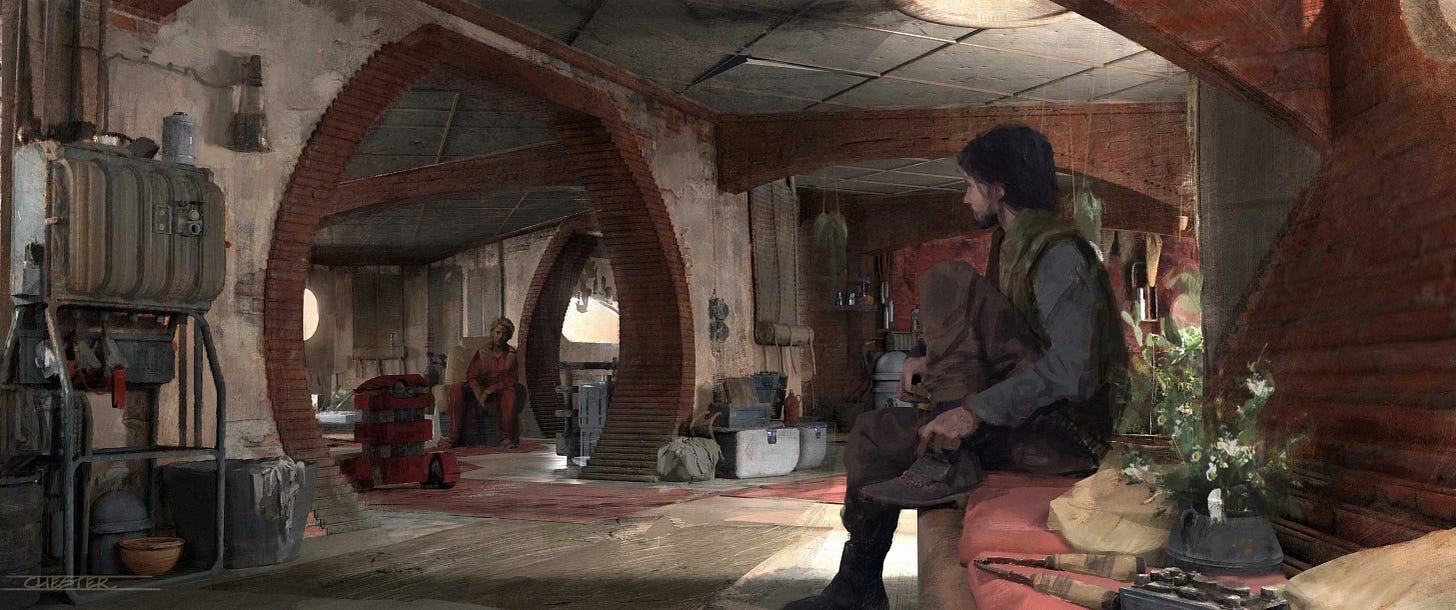
I’m not surprised that the reported budget of the entire series was over $645 million, and that colossal amount of money is felt with every minute shown on screen. In the back of my mind, I was frequently reminded of George Lucas’ proposed live-action Star Wars: Underworld show that never came to pass. Some impressive test footage was leaked online a few years ago, with its gritty tone almost being a dead ringer for Andor. Underworld was similarly intended to be dialogue-heavy, low-level with its storyline scope, and more focused on human drama instead of lighthearted adventure. Over fifty scripts were apparently written and Lucas supposedly had plans for up to 400 (!) episodes, but each costing up to $5 million made the entire series unfeasible to produce.
A single episode of Andor costing about $27 million is ironically far beyond the scale Lucas conceptualized nearly two decades ago. If he had waited just a bit longer for television streaming run by huge media conglomerates like Amazon or Disney to become the norm, his vision for Underworld may have been possible. Still, you don’t have to go far to see just how unsatisfied both audiences and people in the industry are with the current media landscape. Despite smaller episode counts, subscription costs are rising, shows take far longer to produce, and the quality is arguably getting worse. Disney has played a huge role in this, to the point where CEO Bob Iger has even admitted they’ve gone overboard with too much content.
Andor subverts all these trends by having in-depth episodes which tell meaningful stories, not being an expensive vanity project, and actually striving to be something more than a disposable Star Wars spin-off. It fulfills the promises of what streaming-exclusive television should have been and is probably the closest we’re ever going to get to Underworld. Unfortunately, Disney is unlikely to do anything like Andor again. Viewership for its second season was noticeably better than its first, but it still paled in comparison to The Mandalorian and Obi-Wan Kenobi which are closer to what the general public considers Star Wars to be. The return on investment for a passion project like Andor just isn’t there — further demonstrating how unsustainable the current model of streaming is.
For everything Andor does right, a segment of the fanbase is additionally in doubt if it truly “represents” Star Wars. With nary a lightsaber or Force move in sight, there’s possibly an argument to be made that straying too far from the mysticism of George Lucas takes the magic out of Star Wars. The Empire in Andor is more brutal than ever and we regularly see their atrocities. The Ghorman Massacre, previously only referenced in a few books and the Star Wars: Rebels animated series, is front and center as a major event. Early into the second season, a female character is subjugated to attempted sexual assault by an Imperial officer with the word “rape” being explicitly used. This is definitely not a show that children should be watching.
With that said, I still believe that Andor is Star Wars. Going back to the EU comparison, this series is merely attempting a different kind of storytelling. There are plenty of novels and comics which emphasize the totalitarian nature of the Empire, and Andor is in line with a kind of existing Star Wars that deals more with militarism than the Jedi or the Force. It will make you watch Rogue One and the original trilogy in a completely different light after knowing how much was sacrificed for the Rebels to win their victories. Instead of taking away from the achievements of Luke Skywalker and his friends like the sequel trilogy did, Andor enhances existing Star Wars lore while being respectful of what came before it. So yes, I would fully expect the Empire to have rapists, genocide advocates, and other unsavory characters.
With its high production values and mature storytelling, Andor is a miracle of modern television. It dares its audience to consider the implications of how history is shaped by factors both in our control and those forced upon us by oppressive systems. Most hardcore Star Wars fans will appreciate what Andor contributes to the canon, but one need not be a franchise devotee literate in Aurebesh or knowledgable of Tusken Raider burial practices to appreciate its greatness. Tony Gilroy’s show is part sci-fi, part spy story with plenty of influence from heist and prison break thrillers blended in for good measure. If Andor is the only time Star Wars ever attempts to be so ambitious, it will still go down as one of the greats discussed for generations.
Foreign Perspectives is a reader-supported Substack. If you like my work and have come this far, consider opting for a paid subscription so I can continue writing in-depth articles such as these on a regular basis. Your support is greatly appreciated!



